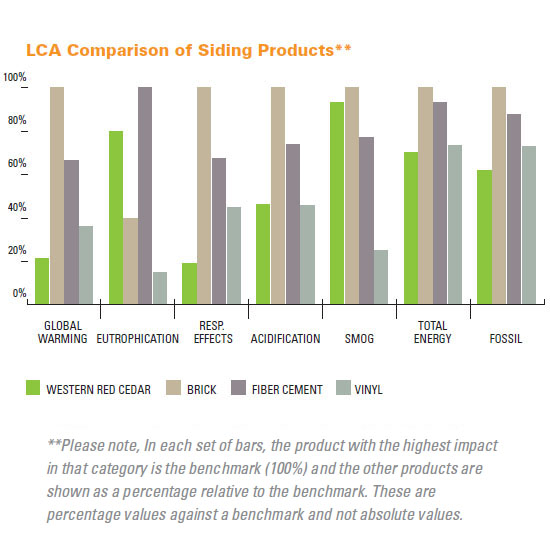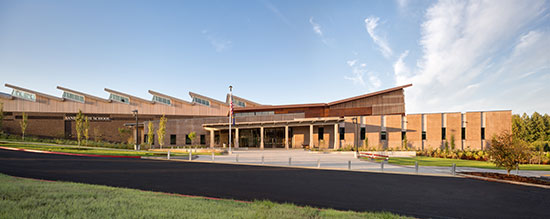Western Red Cedar: Life-Cycle Sustainability, Indoors & Out
LCA Compares Western Red Cedar
With these long-understood benefits, some species of softwoods have been elevated in status as ideal building materials. Western Red Cedar from British Columbia and the Western United States has been tested to quantify its environmental efficacy, and the sustainability data provides environmentalists, architects, and end-users with specific data on how Western Red Cedar contributes to highly sustainable building materials.
With many manufacturers and suppliers and manufacturers touting the environmentally friendly qualities of their products or sourcing methods—many with misleading, single-attribute claims—the WRCLA in 2013 commissioned a third-party LCA to accurately assess Western Red Cedar’s full environmental performance. The life-cycle study was conducted according to the ISO 14040/44 international standard for LCAs, which treats all products equally and calls for peer review following the analysis. The LCA study separately examined several critical stages:
- Cradle-to-gate manufacturing (harvesting, forest management and manufacturing)
- Transportation to clients, installation and use, and end of life (refuse)
- Environmental impact based on six criteria:
- Product or service
- Raw material acquisition
- Energy use and carbon footprint
- Emissions
- Soil and water
- Waste generation
The results on architectural siding and decking produced in Washington State, Oregon, Idaho, Montana, and British Columbia were startling. Western Red Cedar was produced with low-energy extraction and processing methods, and the materials resisted degradation and were found to be highly durable for a softwood product. Comparing Western Red Cedar to virgin and recycled-wood plastic composite decking options, the LCA showed that even in a “worst-case” scenario for Western Red Cedar the wood species would be environmentally favorable as compared to even a “best case” scenario for composite materials, vinyl, fiber-cement, or brick. Summarizing the results, Western Red Cedar was called a “leading building product. . .based on its known three key properties of durability, beauty and value,” according to Jack Draper, WRCLA’s managing director.

Image courtesy of Western Red Cedar Lumber Association
For siding products, Western Red Cedar was compared to other materials and products in an LCA study of various impacts, including total energy.
Some of the green building benefits of Western Red Cedar are unique among softwood species and also among some widely used hardwoods. First, Western Red Cedar is exclusively harvested in North America. Second, forestry practices for this species have stringent standards for compliance. These two benefits ensure that a building project’s materials are not transported from other continents where forest management regimes may be less reliable or nonstandardized. They also help reduce the likelihood that a given supply will not meet the criteria for green building certification.
A third key quality for sustainable design is that Western Red Cedar is very light in weight, which reduces energy consumption during harvesting and transportation and, to a minor degree, reduces the cost and weight of structural backup systems. For the consideration of transport, however, the benefit is significant in terms of cost and fossil fuel use. WRCLA’s Mackie compares a hypothetical project cladding shipment for a large commercial building: Every vehicle can deliver a full truckload of kiln-dried Western Red Cedar without exceeding the maximum weight allowance, yielding about 20,000 square feet of finished wall. Another cladding product, fiber-cement paneling, weighs more per square foot of facade area. In fact, the trucks cannot be filled completely before they hit the maximum weight allowance, and each truckload will cover only about 8,000 square feet of facade area.
A fourth area of consideration could be called practicality, says Mackie. “Wood is considered a very sensible specification by architects who are knowledgeable about its use,” he explains. “In the building operations phase it is a very low-maintenance item. And overall first costs and operational costs show it to be a cost-effective material selection for cladding, fences and decks, interior paneling, and more.” Mackie adds that the natural supply of Western Red Cedar has remained the same in recent decades, so its supply and price fundamentals are strong. In British Columbia, he adds, about 20 percent of the coastal forests are Western Red Cedar, an incidental species—meaning it does not grow as forests but rather as individual trees. All of the suppliers in the WRCLA meet the requirements of certification and the principles of sustainable forestry.
As a fifth area of consideration, visual appeal and humanistic considerations may not be included in ISO protocols for life-cycle assessment, but an increasing number of architects and related experts urge that these qualities always be considered in building projects. How a place feels makes a big difference in its long-term value, and both indoors and outdoors, woods like Western Red Cedar can have a soothing natural appeal. This ranges from the decorative value and rustic charm when specified in knotty grades, or the modern sophistication imbued by the clear grades.
“People who like being outdoors on a deck usually like being part of their natural surroundings,” says WRCLA’s Mackie, articulating the appeal of natural products as compared to the synthetic character of some composites. “If that’s the case, choosing a natural product like cedar is the way to go,” he adds. “People who like to be outdoors or closer to nature prefer to spend time with all-natural materials.”
From residences to commercial and institutional projects—including midrise and high-rise buildings—many designs are incorporating Western Red Cedar not only on balconies and rooftop decks, but also as facade cladding material. Examples include every store worldwide for Illinois-based retailer Crate & Barrel, and schools like the award-winning, LEED Gold Sandy High School in Sandy, Oregon, designed by Dull Olson Weekes–IBI Group Architects to engage the regional Cascadian architectural style of the famous Timberline Lodge. Other projects include university buildings, public libraries, and dozens of recently built hospitality structures. In many of these cases, architects combine indoor and outdoor uses of the wood to create visual continuity that adds to the natural appeal of the wood surfaces and structures.

Photo courtesy of Josh Partee
An increasing number of building projects using Western Red Cedar are large-scale commercial and institutional in nature, such as Sandy High School in Oregon, designed by Dull Olson Weekes–IBI Group Architects.









